class: center, middle, inverse, title-slide # School diversity across different school districts and in different school years ## In school years 1994-1995 and 2016-2017 ### Team DD <br> Erin Mill, Heyuan Wang, Wenyue Cao ### University of Edinburgh ### 2020-12-04 --- class: center, middle # Question ## To identify the most and least diverse type of school district and to compare the changes in school diversity of the school years 1994-1995 and 2016-2017. --- class: center, middle # Hypothesis ## Large cities will have the greatest diversity and remote rural areas will have the least diversity. ## There will be more diversity in school districts in the school year 2016-2017 compared to 1994-1995. --- class: inverse, center, middle # About the dataset --- ## About the dataset and points to note -- - This is a TidyTuesday dataset and the data comes from The Washington Post and the analysis used the Common Core of Data from the National Center for Education Statistics (NCES). -- - A data frame with 27,944 rows and 15 variables where each row represents a school district for each school years that we analysed -- - The analysis only looks at US elementary schools --- # Points to note -- - The school year 1994-1995 is the earliest near-comprehensive data and the school year 2016-2017 is the latest available data. -- - Diversity was defined by the proportion of students in the dominant racial group. -- - Diverse districts are places where fewer than 75 percent of students are of the same race -- - Undiverse districts are where 75 to 90 percent of students are the same race -- - Extremely undiverse districts are where more than 90 percent of students are the same race --- class: inverse, center, middle ## Investigating which school district types are most and least diverse --- class: center, middle 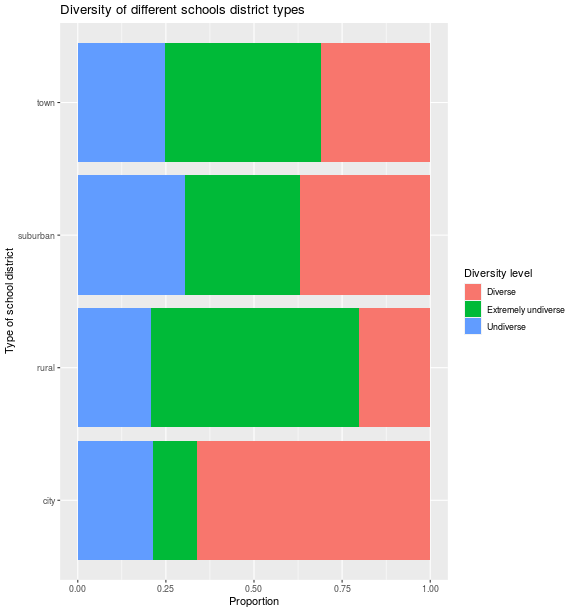<!-- --> --- ## Analysis .pull-left[ 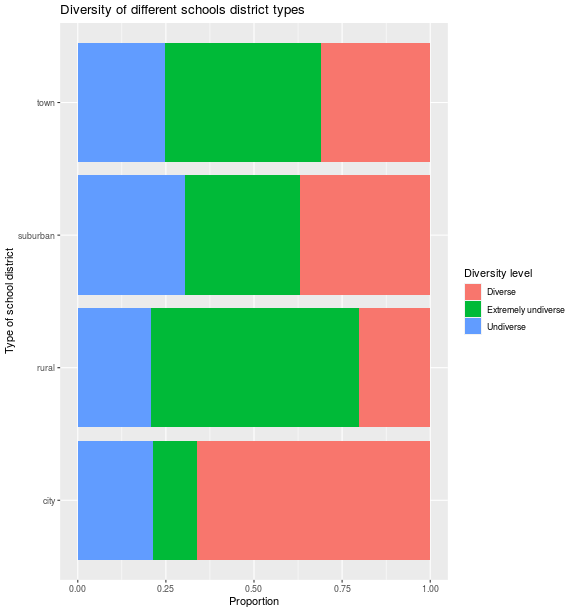<!-- --> ] -- - Around 65% of school districts in cities have a diverse rating whilst a lower proportion of school districts have a diverse rating in other district types -- - Around 60% of school districts in rural areas have an 'Extremely Undiverse' rating whilst only around 20% have a 'Diverse' rating. --- class: inverse, center, middle # Looking closer at the types of school district --- class: center, middle <!-- --> --- ## Analysis .pull-left[ 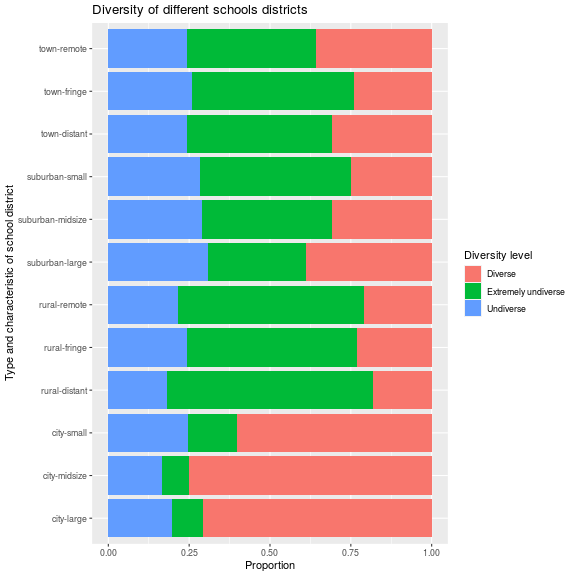<!-- --> ] -- - Midsize cities have the most diverse school districts with around 75% of school districts having a 'Diverse rating'. -- - Distant rural districts are the least diverse with around 60% of school districts having an 'Extremely Undiverse' rating. -- - Both of these results contradict our hypothesis. **Why?** --- # Why are rural-remote districts more diverse than rural-distant districts? -- - Rural remote areas were defined to be areas more than 25 miles from an urbanized area and is also more than 10 miles from an urban cluster -- - Rural distant areas were defined to be areas more than 5 miles but less than or equal to 25 miles from an urbanized area, as well as rural territory that is more than 2.5 miles but less than or equal to 10 miles from an urban cluster ``` ## # A tibble: 2 x 2 ## d_Locale_Txt mean_total ## <chr> <dbl> ## 1 rural-distant 865. ## 2 rural-remote 447. ``` --- class: inverse, center, middle # Comparing diversity of two school years --- class: center, middle 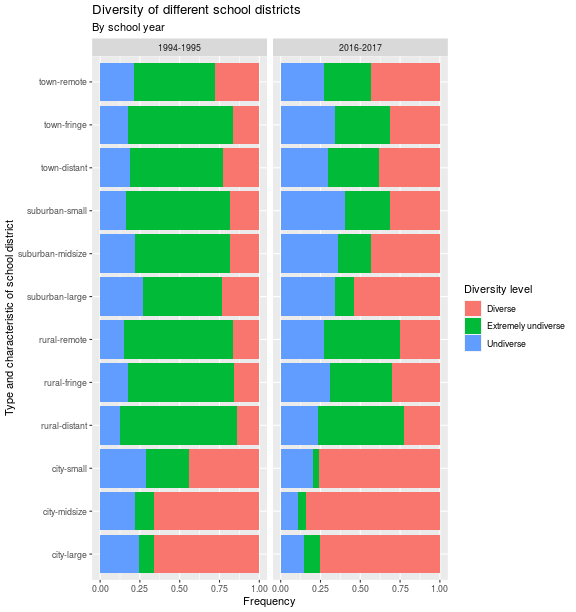<!-- --> --- # Possible reasons that midsize cities are most diverse .pull-left[ <!-- --> ] -- - Large increase in the proportion of school districts with a diverse rating in small city districts when comparing the two school years -- - It may be that immigrants prefer smaller cities to larger cities due to cheaper cost of living. -- - A possible conclusion for mid-size cities being more diverse is that you get the best combination of the 'city buzz' and cost of living. --- # Comparing the diversity in the two school years .pull-left[ 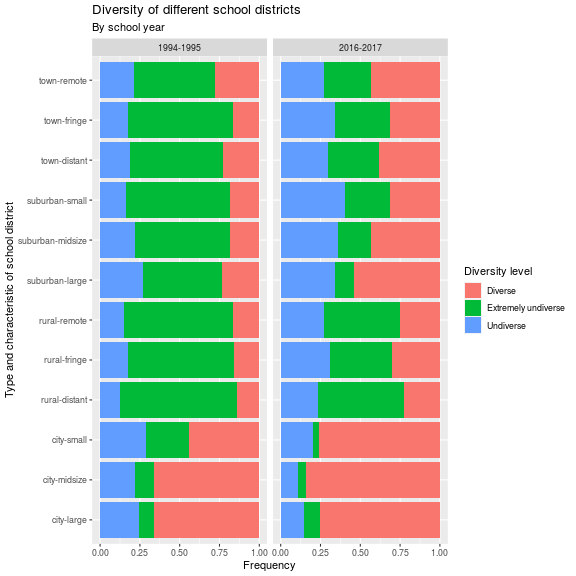<!-- --> ] -- - Greater diversity in school districts in the school year 2016-17 compared to 1994-95 -- - Proportion of school districts with a 'Diverse' rating is greater in 2016-17 for all school district types -- - Development of transportation -- - Educational improvement --- # Looking further into changes in diversity .pull-left[ 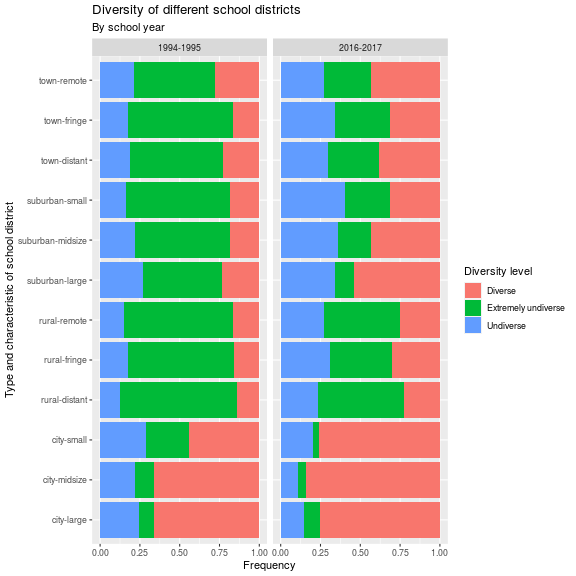<!-- --> ] -- - School districts in small cities had the largest increase by around 31% -- - More jobs are available in cities -- - Smaller cities have a cheaper cost of living -- - Rural-distant and rural-remote school district types have the smallest increase in diversity by around 9% -- - Lack of jobs, homes and buildings --- # Things to think about -- - Integration is a measure that analyses how evenly the districts diversity is spread across the schools in that district - This would be a useful measure to analyse -- - Use data from kindergarten and high schools -- - Compare this with diversity in universities